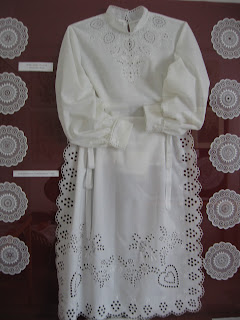My interest was in Hövej embroidery or lace, but there are many other types of lace made in Hungary. You are probably familiar with Kalocsa Lace. Kalosca lace includes brightly colored flowers which are embroidered by hand. The surrounding area is then cut out and machine embroidered to create a lacy effect. Another popular lace in Hungary is called Halas Lace. Halas lace was developed in the small village of Kiskunhalas, located about a hundred miles south of Budapest. This lace is worked with a needle and thread over a paper pattern. From what I have read, this type of lace is quite rare as there are not very many lacemakers making it today. Here's a link to an interesting article on the internet if you would like to read about these two types of Hungarian Lace: Lacemaking in Hungary.
And so we return to Hövej. I want to share with you some additional photos of this beautiful embroidery; this time from the Csipke Museum in Hövej.
The pieces in this museum have been collected by the village and have been made by a variety of different women.
Sorry for the reflections in the glass! Of particular interest to me were some of the framed patterns that were displayed. I'm certain that they were quite old!
Proof that there must have been a pattern book of some kind at one time!
More beautiful Hövej embroidery:
When I sit down at the end of the day to stitch, it's usually so that I can steal a few minutes of quiet time, to relax and unwind after a busy day. The pieces that I make are for my own enjoyment, or I give them as gifts to friends and family. I'm rarely under a time constraint and often work on certain pieces for months on end.
These women rarely stitched for themselves. They generally had orders to fill for the Handicraft Cooperative which then sold the pieces to the wealthy people in Kapuvar; many of the pieces were sold to the Swiss, and some pieces made their way to the U.S. The women relied on the income from their embroidery to help support their families.
I'm glad that the village of Hövej has taken steps to preserve this part of their history. It was encouraging to see that there are women in the village today who want to learn how to do it so that the tradition of making Hövej lace will continue.






















8 comments:
It's all so lovely! Thanks for a last look at the beautiful work of these ladies.
This would be a wonderful tradition to learn. I loved seeing these pictures!
These ladies did amazing beautiful work. Thanks so much for sharing.
I have followed your posts with great interest and thank you for sharing this with us. I would never have had the opportunity to savour this beautiful form of embroidery otherwise.
Such beautiful handwork! Thanks for sharing the photos.
Lovely museum, such amazing work.
Beautiful! Next time I am able to go to Hungary, I plan on going to check this out as well as the Havasi csipke- I was very lucky to be gifted a small masterpiece of it a few years ago
Thank you for sharing!
Thank you for sharing these photos Cathy. This is a beautiful art form and I wish I could have seen it in person.
Post a Comment